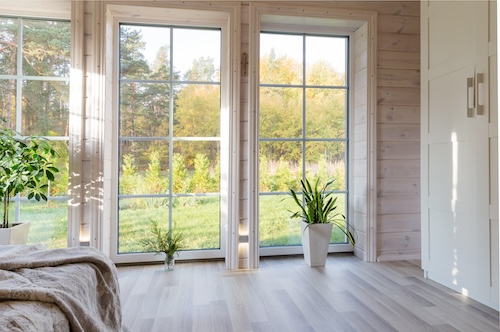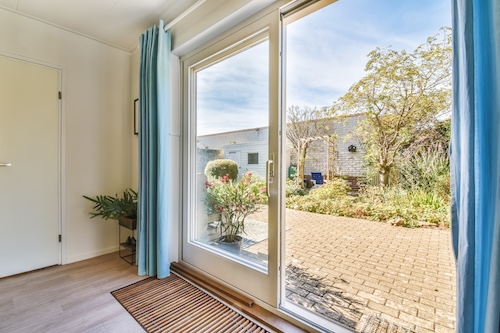Windows play a crucial role in passive solar design, as they are one of the five components needed for this natural heating method. Let’s explore passive solar design and how to choose the right windows for your home.
What is Passive Solar Design?
Passive solar design refers to using the natural heat and warmth of the sun to heat and cool a home or living space. Passive solar heating collects heat from sunlight during the day and releases heat in the evening when it’s colder or throughout the day to reduce temperature fluctuations.
Successful passive solar design involves five key elements:
- Aperture: The entry point for sunlight into the building. (Spoiler alert: This is where windows come in!)
- Absorber: Dark surface in the direct path of the sunlight, usually the wall or flooring.
- Thermal Mass: Materials underneath the absorber that store and retain heat.
- Distribution: The way the heat is circulated throughout the house. For a fully passive design, this will use conduction, convection, or radiation for natural heat transfer. Otherwise, fans, ducts, and blowers may be used.
- Control: Additional elements are used to control the amount of sunlight coming into the home or expel excess heat. This can include window overhangs that block summer sun, shades, vents, fans, and dampers.
Benefits of Passive Solar Design
When designed effectively, passive solar heating for residential homes has many benefits.
Energy Efficiency
Because a natural resource (the sun) is used instead of electronic or gas heating and cooling, solar heating is very energy efficient. The result is lower energy bills and more environmentally friendly living.
Affordability
Compared to active solar heating systems — which involve more technology and maintenance for greater efficiency and control — passive solar heating is simple and affordable, requiring very few components and no technology support.
Flexibility
You don’t have to fully commit to a passive solar heating system to utilize the concept for lowering your energy consumption! Through strategically placed windows and creative choices in household materials, you can enjoy some benefits of solar design without completely remodeling your home.
How do Windows Contribute to Passive Solar Design?
Windows are a significant component of passive solar design because they serve as the aperture, or “collector” of solar energy. By placing windows in strategic locations where they can effectively direct sunlight, you can naturally heat your home and reduce the strain on your heating and cooling systems.
Windows for passive solar design should provide decent wall coverage and allow an appropriate amount of sunlight to enter your home, but they should still be well-insulated and have low air infiltration ratings for optimal control and energy efficiency.
Best Windows for Passive Solar Design
When it comes to solar heating, windows on each side of the home will serve a different role. Knowing how the windows will contribute to solar heating (for better or worse!) is important so you can place windows in your home design as strategically as possible and choose the right types of windows for each part of your home.
North-Facing Windows
North-facing windows are the least useful for solar heating, though they still provide benefits and value to your home. Because you don’t get a lot of direct sunlight from the north, particularly during winter months, north-facing windows are ideal for increasing natural light in your home while neither gaining nor losing heat.
Because these windows won’t effectively collect solar energy, it’s best to use windows with Low-E glass that blocks UV rays and provides the most energy-efficient insulation possible.
South-Facing Windows
The south side of your home is the most important area for window solar heating! The best passive solar design will have enough window coverage on the south side to cover seven to fifteen percent of the floor’s surface, though it’s best to stay under ten percent to avoid overheating unless you live in a particularly cold area.
South-facing windows should have both Low-E and high solar heat gain, with a solar heat gain coefficient (SHGC) of 0.3 to 0.6. In areas like Kansas City where the summers can be hot and the winters cold, the SHGC should be on the lower end to avoid overheating when cooling is needed.
East-Facing Windows
While nice for early birds who enjoy watching the sunrise, east-facing windows don’t contribute much to energy performance with passive heating. They can contribute some morning heat in the winter and less desirable heat in the summer, but generally, their effect is neutral. If your east-facing windows are causing overheating, strategic overhangs or shading can do the trick. You could also consider installing tinted glass or smart glass to block glaring morning rays.
West-Facing Windows
Windows on the westward side of your home are the most notorious contributors to overheating. Even west-facing walls without windows have been known to allow in excess heat from the sun if not properly shaded.
To keep window solar heating as controlled as possible, any west-facing windows should have very low SHGC glass and deep overhangs to reduce direct sunlight. Landscaping and covered porches are beautiful options for shading west-facing windows and creating an enjoyable outdoor environment for watching the sunset!
Need to Update Your Solar Heating? Try Replacing Your Windows!
If you use passive solar heating or are interested in incorporating the principles into your home, new windows are a great way to optimize solar heating without compromising insulation.
Contact Rolox Home Service to learn more about our solar heating window options!





